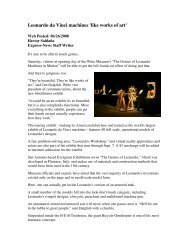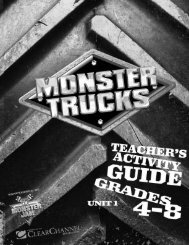Extreme Deep Teacher's Guide.pdf - Evergreen Exhibitions
Extreme Deep Teacher's Guide.pdf - Evergreen Exhibitions
Extreme Deep Teacher's Guide.pdf - Evergreen Exhibitions
You also want an ePaper? Increase the reach of your titles
YUMPU automatically turns print PDFs into web optimized ePapers that Google loves.
Hundred-Inch Hike<br />
ACTIVITY<br />
Materials<br />
■ stopwatch<br />
■ magnifying glass<br />
■ pencil and paper<br />
Questions to Begin<br />
■ How to scientists make discoveries? (Have students offer their points of view, then explain the<br />
OPENS method.)<br />
Procedure<br />
1. Lay a 100-inch tape measure across each of several microhabitats on or near your school<br />
grounds. Possibilities include the sidewalk, lawn, forest trail, garden edge, meadow, etc.<br />
2. Instruct students that they’re going on a 100-inch adventure.<br />
3. Have students pick (or assign them to) one of the microhabitats.<br />
4. On their hike, students will make a list of 5 observations in one column, and a list of inferences<br />
(possible meanings) about those observations in another column (see the Observation Sheet).<br />
For instance, if a student notices a leaf that has a hole in it, she might write “leaf with hole in<br />
center” in the observation column and “a caterpillar chewed the hole” in the inferences column.<br />
5. Gather students together and have each make a list of evidence they’ll need to support each of<br />
their inferences. For the caterpillar example, finding a caterpillar eating the same kind of leaf<br />
and leaving a similar pattern would be strong evidence to support the inference.<br />
6. Return to the micro-hikes areas and have students collect evidence to support or refute one of<br />
their inferences. If there’s time, have them bolster their findings with additional evidence from<br />
nearby areas.<br />
7. When they’re done, have students present their observation, inference and evidence to support<br />
their discovery to the class.<br />
Questions to Close<br />
■ What was your observation?<br />
■ What inferences did you make about what you observed?<br />
■ What evidence did you find to back up your conclusion?<br />
Adapted from:<br />
Cornell, Joseph. Sharing Nature with Children: Ananda Publications, 1979.<br />
Gross, Phyllis, and Esther P. Railton. Teaching Science in an Outdoor Environment. Berkeley, CA: University of California<br />
Press, 1972.<br />
14





